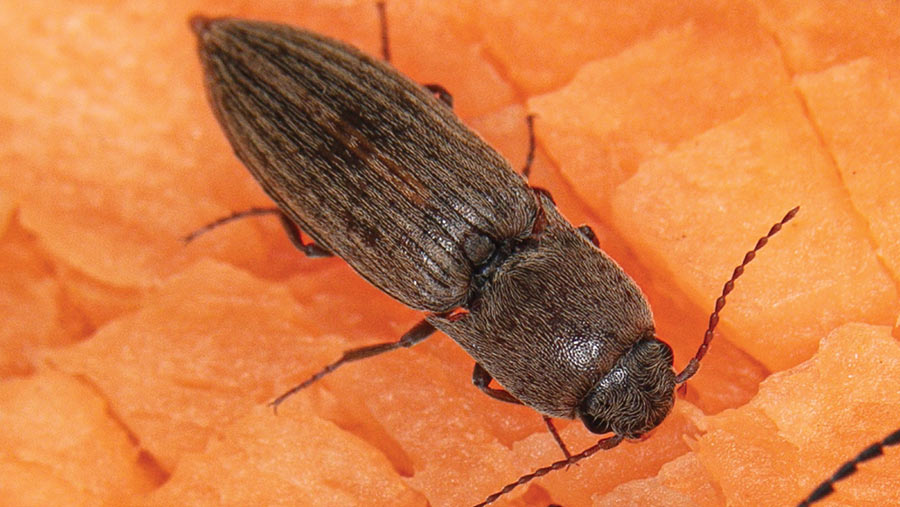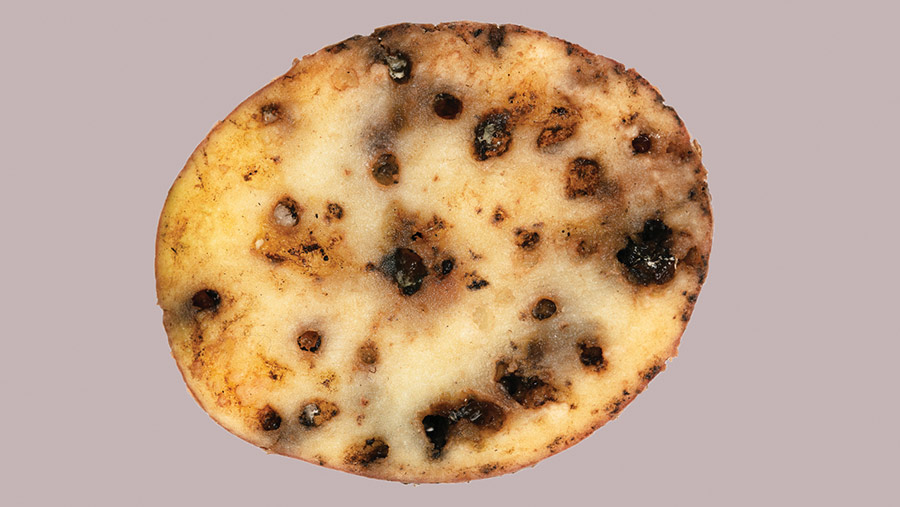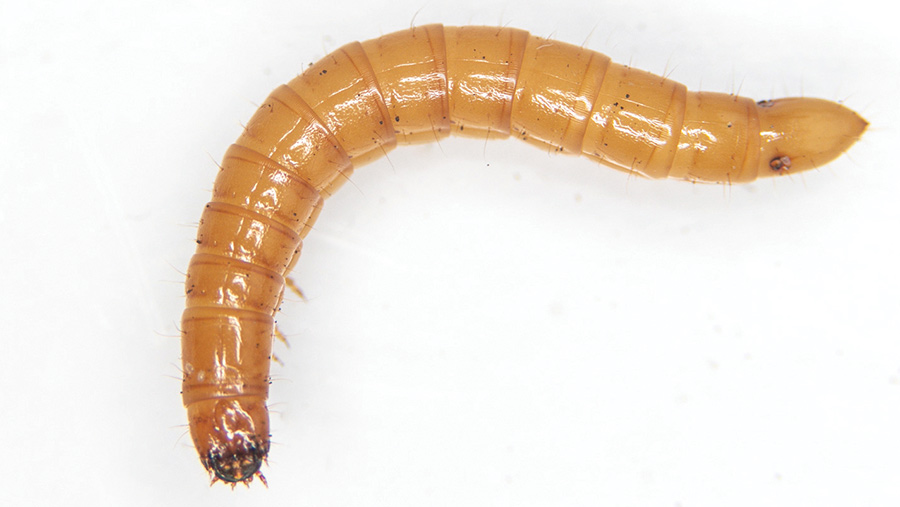How to control wireworm in potatoes effectively
 Adult Agriotes lineatus © Blackthorn Arable
Adult Agriotes lineatus © Blackthorn Arable The threat of wireworm damage is a growing concern for UK potato producers as a perfect storm of risk factors create optimum conditions for the soil-dwelling pest to thrive.
Growers are encouraged to assess overall wireworm risk this autumn by identifying whether damaging species are present and tailoring management accordingly.
Opting for varieties with early lift dates, and selecting the right cultivation and cover crop can help mitigate pest pressure.
See also: Harvest 2023: Potato yields hit by dry early summer
Identifying species
Wireworms are the larvae of click beetles and three members of the genus Agriotes are the main cause of concern for UK growers. These are: A lineatus, A obscurus and A sputator.
Wireworm feed for three to four years in the soil, causing damage by burrowing into roots and tubers, leading to reduced marketability, before finally pupating in the summer of their final year.
Over recent decades, a combination of prohibited chemical use, reduced cultivations and increased area of green cover on-farm has steadily increased pest pressure, particularly in the South.
Damage has extended to crops such as lettuce, onions, cereals and maize.
Martyn Cox, independent agronomist and wireworm specialist, explains how identifying populations using techniques such as bait trapping can help growers implement simple changes on-farm to avoid high-risk areas.
“Identification of the pest is key, as not all wireworms are problematic.
“If Agriotes are present this can completely write off crops. Athous are also damaging. But there are steps to take to mitigate against high-pressure situations,” he says.
Variety selection

Damage to a tuber slice © Blackthorn Arable
Wireworm damage severity differs between potato varieties. Selecting an early-maturing variety can lead to an earlier July harvest.
This otherwise avoids crops in the ground during the major pupation feeding stage that takes place from the end of July to September.
In higher risk areas, growers may consider planting a less-susceptible variety or one suitable to a less-restricted end market.
Varieties such as King Edward and Agria are less susceptible to wireworm damage than the likes of Maris Peer, Rooster and Marfona.
Work continues at the Cambridge University Potato Growers Research Association (Cupgra) to identify the reasons behind this and to assess whether glycoalkaloid levels are as important as initially thought.
“Growing for the processing versus the fresh sector can avoid costly downgrades as different markets have different damage thresholds,” says Martyn.
Cultivation and cropping
Wireworms particularly like damp moist soil conditions, with plenty of green cover and weedy stubbles.
“Larvae feed heavily in the spring, then they tend to go quiet before coming back with a vengeance during end of July to September.”
Growers should prioritise control of juvenile wireworms during the summer months, as this is when they are at their most vulnerable.
Methods of control include:
- An autumn cultivation soon after a cereal harvest to remove the food source, and leave large larvae on the soil surface where they are open to predation
- Avoid over winter weedy stubbles which otherwise promote juvenile survival
- Create a plant-free situation after a cereal crop for a month, immediately after harvest
- A cover crop planted after a month of bare soil with at least 25% buckwheat can be beneficial
- Rotations dominated by cereals are riskier, particularly if volunteers are allowed to survive into late autumn, this is similar to a year of grass
- The onset of wireworm damage can commence early in the growing season so test digs early into potato development can be beneficial. Sampling right at the bottom of the ridge, where damage usually begins, is useful to identify wireworm attack early in the season.

Agriotes larvae © Blackthorn Arable
Setting a bait trap
Bait trapping in the autumn can identify species to increase management options for the season ahead.
Martyn recommends using a mix of untreated maize and wheat seed to avoid seed dressings acting as repellents.
The bait mix can be used in a mesh, or simply placed in a small hole in the ground.
“Soak the grain in water for 24 hours, drain for an hour, then place in a plastic bag to keep it warm and get the shoots growing. Place in the ground at about 4-6in deep,” he explains.
The germinating seed gives off carbon dioxide and attracts wireworm into the trap.
“Sift through the soil to identify if there are wireworms present. You may need specialist advice identifying key species – so do get in touch,” he says.
Autumn sampling is advised, stubbles with volunteers sprayed off are ideal, and ensure a minimum soil temperature of 8.5C, says Martyn.
Fields can be sampled in a traditional “W formation” or at-risk areas can be selected for a closer investigation.
Innovative Farmers wireworm trial at Taylor Organics, Shropshire
Wireworm has been a growing issue for potato farmer Nick Taylor, who runs a 1,000ha organic fresh produce farm in Shropshire.
It was 10 years ago that the soil-dwelling pest started to become problematic for Taylor Organics, particularly when taking on new or rented land.
Over the years, high-risk areas have been identified, responding with a rotation based on green manures, spring cropping and timely cultivations to clear the ground from weeds and reduce the green bridge.
“We have extensively incorporated mustard into the rotation for its biofumigation properties which has certainly helped, but the use of metal work and keeping the ground clean through timely cultivations has been the biggest benefiting factor,” says Nick.
Looking to evolve wireworm control, Nick is taking part in an Innovative Farmers trial assessing practical ways to reduce risks on farm.
Six treatments in randomised blocks have been established, with each plot 6m x 12m in size.
Bare soil, cultivated stubble and two different types of covers have been put to the test:
- Leave stubble
- Leave stubble, then manage weeds with a propane burner
- Leave stubble, then cultivate with a set of discs
- Drill buckwheat cover
- Drill Vittasso brown mustard cover
- Drill Vittasso brown mustard, then incorporate
Pheromone traps have been established to assess the level of adult click beetles.
Independent agronomist Martyn Cox notes that previous UK knowledge of the click beetle has been limited, but Agriotes adult species are now being surveyed with pheromones across most of UK.
Researchers are now aware that we cannot predict a population of larvae from the adult activity level, but this may help predict risk in two to three years.
The team is working closely with Harper Adams University to analyse results and make appropriate recommendations.
What about other direct control methods?
Dr Ben Clunie, entomology lecturer at Harper Adams University, talks us through the pest’s life-cycle and delves into two new control methods that could potentially be on the horizon, alongside two products currently available.
Life-cycle
- September-March: Adults overwinter below soil surface, usually activity begins in the South in late March
- May-June: Females lay eggs just below the soil surface.
- June-July: Eggs hatch.
- July-August: Larvae pupate
- Year-round: Wireworms feed for three to four years. In some areas, this may be shorter
Potential
- Entopathogenic fungi: Novel biological products including entopathogenic fungi-based granules could soon be on the horizon, with some now being used in areas of Europe
- Botanicals and essential oils: This is a growing area of research interest for future wireworm control. Essential oils such as rosemary and cedarwood have shown promising results
Available
- Nemgurade: A garlic-based product for nematode control in carrots, parsnips and sugar beet that has potential for wireworm suppression
- Nemathorin: Containing the active fosthiazate, the product aims to reduce tuber damage caused by wireworm, but it is not a silver bullet and will give about 20% reduction

